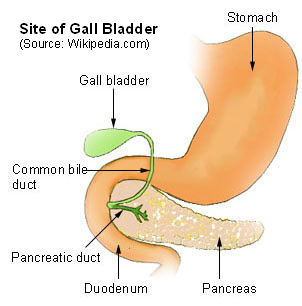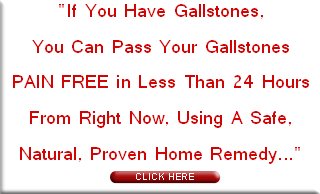Recognize and Overcome
Gall Bladder Symptoms Naturally
Gall bladder symptoms can be intensely painful amd distressing for the sufferer as anyone who has the problem of gall bladder stones and subsequent gall bladder disease will know.
The first time you are struck by an attack of gall bladder pain, because of the site of the likely intense discomfort, it can make you think the worst - such as "heart attack", or perhaps you'll mistake it for a severe bout of indigestion and wonder why your normal antacids do not seem to be helping you.
Inside your body the gall bladder sits right underneath the liver and undertakes a crucial role in producing bile that helps the body to break down and digest fats.

Bile primarily contains a combination of water, fats (including most importantly with respect to gallstones formation) cholesterol, bile salts (that actually break up the fats), proteins and the naturally yellow colored substance called bilirubin, that is excreted into the bile during the process of "haem catabolism", when the blood haemoglobin is broken down. Bilirubin is the factor in blood that makes bruises sometimes look yellowish, and is also the reason for the skin taking a yellow hue in cases of jaundice, when the liver function is impaired. It is also the other major factor in the forming of gallbladder stones

Why Gall Bladder Stones Form
Sometimes when the level of cholesterol and/or bilirubin in the bile becomes too high – due to a biological imbalance – the bile can harden and form granules – or stones - commonly called gallstones. In fact, they can be small – the size of sand grains - or they can become as large as a golf ball. If you are prone to the development of gallstones they can be any size between these extremes and it is very possible that a stone can become lodged in the canal that the bile passes along near to the liver (the hepatic duct). This can result in gall bladder symptoms or gall bladder disease.
Cholesterol based gall bladder stones tend to be larger and lighter colored. Whereas gallstones developing from the agglomeration of bilirubin will be darker colored.
By far the majority of gall bladder stones tend to go unnoticed and cause no noticeable symptoms. But the 10% of stones that do cause the sufferer a problem can invoke excruciatingly painful episodes. This is when gall bladder problems can lead to medical practitioners typically suggesting surgery.
In the very worst case scenario, where gall bladder symptoms become too frequent or hard to bear, a Doctor may advise that the 'only course' of action is to remove the gall bladder surgically. For ageing sufferers of gall bladder disease, in particular, this can be a traumatic choice. Whilst you may have relief from the pain of gallbladder symptoms, you will no longer product bile naturally, so you will be unable to digest fats properly – without a pharmaceutical intervention. In other words taking medication for the rest of your life.
Gall Bladder Disease - Gall Bladder Symptoms
The symptoms of gallstones tend to focus around the mid-upper and right-hand side abdominal area, and behind the breastbone – adjacent to the position of the gallbladder and the bile ducts. This pain is referred to as biliary colic. The pain is often described as 'gnawing', or 'gripping' and can be sharp and intense. Frequently it will occur at night when lying down, some hours after a meal (especially if it has contained fatty ingredients). The pain can also radiate into the upper back and shoulder blade area.
Sometimes gall bladder symptoms can include feeling nauseous and even lead to vomiting.
Unlike forms of indigestion that cause GERD, or acid-reflux, simply sitting up, or taking pain-killers or antacids do not provide relief. The pain is not caused by trapped wind or acidity so although in some respects the gallbladder symptoms are similar their root cause is different.
For many sufferers of gall bladder problems the events can, thankfully, be very intermittent. They may even be a one-off occurrence, or re-occurrences may be years apart. A typical gall bladder pain attack will last perhaps one to several hours. But for some the problem can become more protracted and intense. In these cases of longer-lasting gall bladder symptoms the diagnosis may be of the more serious form of gallbladder problems - "acute cholecystitis". When gallbladder stones start to cause gall bladder pain only about three-in-a-hundred cases become so severe that it is considered to be this acute form of gallbladder problem.
A gallbladder condition called choledocholithiasis can also occur when gallstones become lodged in the common bile duct. In this instance gall bladder symptoms may extend to the sufferer becoming jaundiced (yellowing skin tint), seeing their urine become dark yellow, and possible their stools becoming lighter and more yellowish. They may also experience a drop in blood pressure and a rapid heartbeat. Sometimes the gall bladder symptoms can include feverishness, and chills and this along with the severe pain, and likely nausea and vomiting, may suggest that the bile ducts have become infected, a condition called cholangitis.
Gall Bladder Cleansing and Diet for Gallstones
Yet, even the more severe cases of gall bladder symptoms can often be overcome and settled by using a gall bladder cleanse and adopting a modified diet for gallstones pain management.
A gall bladder cleanse can flush the gall bladder and bring gall bladder stones away - including even quite large stones.
A gallbladder diet will then also help to re-balance the body and reduce the likelihood of further stones forming.
You can read more details about a guaranteed method for overcoming gall bladder symptoms naturally and effectively, wthout having to resort to surgery and gallbladder removal, right here:
Gall Bladder Cleanse - Save your Gall Bladder!
Go to top of Gallbladder Symptoms page.